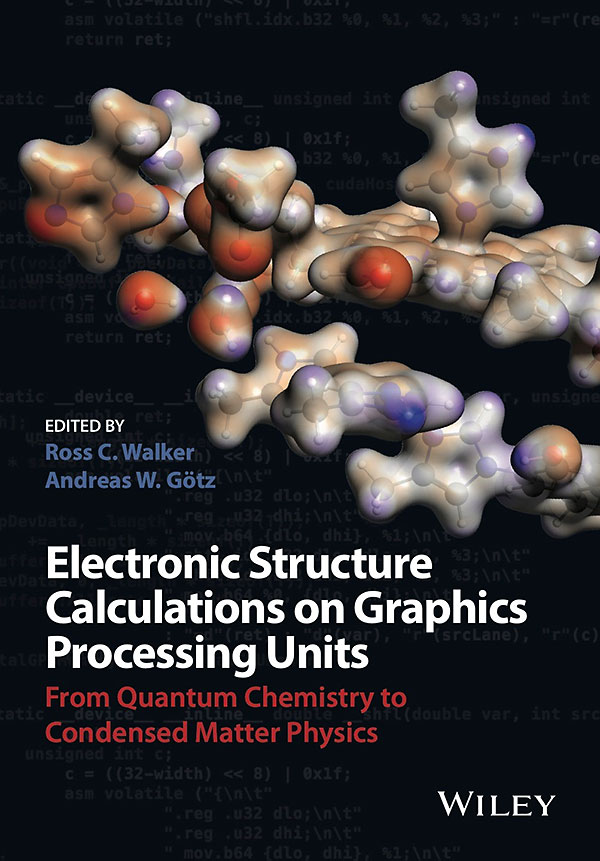

 Skip to navigation
Skip to navigation
Site Primary Navigation:
- About SDSC
- Services
- Support
- Research & Development
- Education & Training
- News & Events
Search The Site:

Published May 2, 2016

Two researchers with the San Diego Supercomputer Center (SDSC) at the University of California San Diego are editors of a just-published book that explores the latest developments in electronic structure calculations on modern computer hardware and explains how graphics processing units (GPUs) can be efficiently exploited to perform such calculations more rapidly than previously possible.
The book, entitled “Electronic Structure Calculations on Graphics Processing Units – From Quantum Chemistry to Condensed Matter Physics” is co-edited by Ross Walker, an associate research professor with SDSC and adjunct associate professor in UC San Diego’s Department of Chemistry and Biochemistry; and Andreas Goetz, a computational scientist with SDSC and co-director of the NVIDIA GPU Education Center at SDSC.
Walker and Goetz, who authored three of the 14 chapters, introduce readers to GPU programming concepts and the essential background on electronic structure theory while the remaining chapters provide the latest examples of code developments and applications for the most widely used electronic structure methods. Electronic structure calculations are used in fields as diverse as chemistry, molecular biology, and materials science, while GPUs, originally designed for video games, are now used across a wide range of science domains to solve computationally intensive tasks very efficiently.
“Everything that surrounds us is made of atoms and electrons, from the smallest molecules to extended materials and all living matter,” said Walker, who also directs the Walker Molecular Dynamics Lab at SDSC and the GPU Education Center. “The electrons are the ‘glue’ that keeps the atoms in molecules and materials together and determines their properties.”
Understanding the electronic structure of molecules and materials is of fundamental importance because it permits scientists to better understand the behavior of matter at the nanoscale while allowing for the design of improved materials, drugs, and other key chemicals. Since electrons are very small elementary particles that move according to the laws of quantum mechanics, this requires solving the electronic Schrödinger equation.
“It is truly fascinating that we can use the laws of quantum mechanics to understand what the electrons in molecules and materials are really doing”, said Goetz. “Electronic structure calculations are used in a wide range of applications, for instance to understand chemical reactions in enzymes or catalysts, for computational drug design, or to design materials for high-efficiency photovoltaic cells.”
Because analytical solutions to the Schrödinger equation are not known for many-electron systems, one has to resort to numerical approximations. “The major challenge is the complexity and numerical intensity of these calculations,” added Goetz. “They require significant amounts of computational resources.”
This is where GPUs, massively parallel processors with hundreds to thousands of processing units, come in. “Over the last few years there has been a tremendous growth in numerical simulations that make use of GPUs, spanning all fields of science,” said Walker. “Originally designed for specialized graphics applications and visualizations, GPUs are now ubiquitous in mainstream computing platforms and many of the most powerful supercomputers.”
“We are grateful for all the excellent contributions from leading scientists in the field,” said Walker and Goetz. “We hope that our readers will find the book an engaging and useful reference.”
The book went on sale in Europe on March 21st and is available in the U.S. starting this month.
R. C. Walker and A. W. Götz, Editors, “Electronic Structure Calculations on Graphics Processing Units – From Quantum Chemistry to Condensed Matter Physics”. Published by John Wiley & Sons Ltd., 2016. ISBN 978-1-118-66178-9.
About SDSC
As an Organized Research Unit of UC San Diego, SDSC is considered a leader in data-intensive computing and cyberinfrastructure, providing resources, services, and expertise to the national research community, including industry and academia. Cyberinfrastructure refers to an accessible, integrated network of computer-based resources and expertise, focused on accelerating scientific inquiry and discovery. SDSC supports hundreds of multidisciplinary programs spanning a wide variety of domains, from earth sciences and biology to astrophysics, bioinformatics, and health IT. SDSC’s Comet joins the Center’s data-intensive Gordon cluster, and are both part of the National Science Foundation’s XSEDE (eXtreme Science and Engineering Discovery Environment) program, the most advanced collection of integrated digital resources and services in the world.
Share